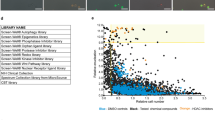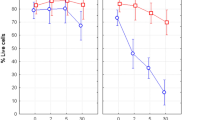Abstract
Hydroxyurea has been used to synchronize cultured cells to S-phase and used to treat patients with sickle-cell anemia. Recently, we found that hydroxyurea can induce the apoptosis of HEL (human erythroleukemia) cells. The induced HEL cells showed ultrastructurally chromatin condensation with regular crescents at the nuclear edges and apoptotic bodies. However, the cells of K562, another human erythroleukemia cell line, did not show such morphological changes. Under fluoroscope, the HEL cells after induction often displayed a clear reduction in nuclear diameter and nuclear chromatin cleavage and condensation and the presence of nuclear ring and apoptotic bodies. Analysis with flow cytometry showed that the percentage of apoptotic cells is about 30-40% after HEL cells were induced by hydroxyurea for 3 days. DNA ladder can be observed by electrophoretic analysis.
Similar content being viewed by others
Introduction
Apoptosis (programmed cell death) plays a fundamental role during invertebrate and vertebrate development. The origin of human cancer may be associated with the failure of endangered cells to undergo apoptosis. Apoptosis has been observed in many different cells and in response to many physiological signals or types of stress 1, 2. It can be induced by glucocorticoid treatment, exposure to Ca2+ ionophores or γ-irradiation of mouse thymocytes and growth factor deprivation of both hematopoietic and lymphoid cells in vitro3, 4. Hydroxyurea can stimulate fetal hemoglobin synthesis, which seems to palliate sickle-cell anemia5. It has been known that hydroxyurea can inhibit DNA synthesis without immediate effect on RNA or protein synthesis6. Ribonucleotide reductase was identified as the target enzyme of hydroxyurea in different kinds of organisms7. In the present paper, our data showed that hydroxyurea could induce HEL cells to exhibit the characteristics of apoptosis.
Material and Methods
Cell culture
HEL cells and K562 cells were grown in RPMI-1640 medium (GIBCO-BRL) supplemented with 10% heat-inactivated newborn calf serum, streptomycin (100 μg/ml), and penicillin (100 units/ml). Hydroxyurea (Sigma product) was added to the medium to make its final concentration 150 μmol/L for HEL cells and 200 μmol/L for K562 cells respectively.
Electron Microscopy (EM) analysis
HEL cells and K562 cells were treated with hydroxyurea for 3–5 days and 5 × 106 each of these treated cells, together with their untreated controls, were fixed with 2.5% glutaraldehyde for 45 min; and postfixed with 1% OsO4 for 1 h. After dehydration, embedded in #618 epoxydic resin for 2 h. and then sectioned. The samples were routinely stained and examined by E.M..
Fluoroscope observation
After seeding at a density of 2 × 105/ml, HEL cells were grown for three days with or without hydroxyurea in RPMI 1640 medium. Collecting cells by 500 g centrifugation, then resuspending the pellets with 1 × PBS and washing twice, the cell pellets were gently resuspended in 1.5 ml hypotonic fluorochrome solution (PI 50 μg/ml in 0.1% sodium citrate and 0.1% Triton X-100.). Then the nuclei of the ceils were observed under the fluoroscope.
Flow cytometry
Flow cytometry analysis was performed as described8. The cells were resuspended in the citrate solution (40 mmol/L sodium citrate pH 7.6, 250 mmol/L sucrose, 5% v/v DMSO.). The suspension was stored at −20 °C for 20 min, then thawed rapidly at room temperature and centrifuged to collect the cells. The cells were put in solution A (NP-40, trypsin and spermine tetrahydrochloride) for 10 min. and then in solution B (trypsin inhibitor and RNase A) at room temperature for 30 min. Finally. the cells were stained with propidium iodide and analyzed by flow cytometry.
The examination of DNA fragmentation
For DNA agarose gel electrophoresis, DNA was extracted as described9 with some modifications. 2 × 107 HEL ceils were incubated with or without hydroxyurea for 3 days at 37 °C. The cells were washed twice with 1 × PBS, centrifuged at 500 g for 10 rain, resuspended in hypotonic lysing buffer (100mmol/L NaCl , 10mmol/L Tris.HCl, 1mmol/L EDTA, 1% SDS and 200 μg/ml proteinase K pH 7.5) and incubated for 3-5 h at 55 °C. Samples were extracted with phenol: chloroform (1:1 v/v) and then with chloroform. RNase A (100 μg/ml) was added to incubate with the water-soluble phase at 37 °C for 1 h to digest RNA. The DNA pellets were dried and dissolved in 1 × TE buffer and were taken to analyze with electrophoresis.
Results
Chromatin condensation of HEL cells induced by hydroxyurea
By analysis with E.M., we found that the nuclei of uninduced HEL cells were very irregular in shape, with many gulfs and protrusions (Fig 1A). After HEL cells were induced by hydroxyurea for 3–5 days, the chromatin was condensed to form clumps, which pressed against the nuclear envelope (Fig 1B), or formed regularly shaped crescents at the nuclear edges (Fig 1C). Our previous studies demonstrated that the proliferation of the induced K562 cells was slowed down10. After 3–6 day induction with hydroxyurea, K562 cells became larger than the uninduced ones and had a high cytoplasm to nucleus ratio (Fig 1 D and E). However, K562 cells did not show other characteristic morphological changes of apoptosis as HEL cells.
Ultrastructure of HEL cells and K562 cells with or without the induction by hydroxyurea. The nuclei of healthy HEL cells and K562 cells are very irregular in shape, with many gulfs and protrusions(A: 5000X and D: 6000X respectively). After HEL cells were induced by hydroxyurea, the chromatin of HEL cells became condensed (B: 5000X) and the HEL cells appeared with irregularly shaped crescents (C: 5000X). However, K562 cells did not show the morphological changes of apoptosis after hydroxyurea was added (E: 3000X).
Identification of HEL cells apoptosis by using flow cytometry and fluoroscope
To demonstrate the apoptosis of HEL cells, we further analyzed the uninduced and induced HEL cells by using flow cytometry. Apoptotic cells could be detected as an unequivocal hypodiploid DNA peak. The percentage of apoptotic ceils is about30–40% in the induced HEL cells, but is only 3–4% in the uninduced HEL cells. (Fig 2B and 2A).
By using a fluoroscope, we observed that the majority of hydroxyurea treated HEL cells displayed a clear reduction in nuclear diameter. Some nuclei exhibited chromatin fragmentation and condensation (Fig 3A), and in other nuclei, ring structure and crescent-formed bodies were seen (Fig 3B). Others formed apoptotic bodies with internucleosomal cleavage of chromatin (Fig 3C). On the contrary, the untreated HEL cells did not show these morphological changes (Fig 3D).
HEL cells under fluorescence microscope. The nuclei of the induced HEL cells exhibited chromatin fragmentation and condensation (A: 900X), ring structure and crescent changes (B: 900X) and chromatin cleavage (C: 900X), as compared with the nuclei of HEL cells without induction by hydroxyurea (D: 900X).
DNA laddering
Cells undergoing apoptosis had their DNA digested in the internucleosomal region and displayed the characteristic nucleosomal ladder on agarose gels. In our experiments, the HEL cells treated with hydroxyurea displayed typically nucleosomal cleavage after 2 days hydroxyurea treatment, which was not seen in the uninduced HEL cells (Fig 4).
Discussion
Hydroxyurea can lead to cell growth arrest in the S phase of the cell cycle. Some studies demonstrated that hydroxyurea can inhibit ribonucleotide reductase, which is important for deoxynucleotide supplement in the living cells11. Al-Khodairy and Carr12 found that hydroxyurea can arrest the mitosis of some cells of Schizosaccharomyces pombes. They also found some bus (hydroxyurea sensitive) genes which are necessary for checkpoint control in chromosome segregation13, 14 and one of these genes could encodes a ubiquitin-conjugating enzyme required for normal mitosis15. However, the molecular mechanism of the action of hydroxyurea is still unknown.
Both HEL cells and K562 cells are human erythroleukemia cell lines. The K562 cells express human embryonic (ε) and fetal (γ) globin genes, but not the adult (β) globin gene. The HEL cells, however, express mainly human fetal (γ) globin gene and trace amount of the embryonic (ɛ) globin gene, but not the adult (β) globin gene. Our previous studies10, 16 demonstrated that hydroxyurea can inhibit the proliferation of both K562 and HEL cells and stimulate the expression of adult globin gene. These results suggested that hydroxyurea can induce the differentiation of both cell lines10, 16. In addition, hydroxyurea can inhibit cell S-phase progression.
The mechanism that regulates cell death is essential for normal development. In order to elucidate the molecular mechanisms of the action of hydroxyurea in regulating cell proliferation and differentiation, we have examined its possible roles in cell death. By using electron microscopy, we found that HEL cells treated with hydroxyurea showed the apoptotic morphological characteristics: chromatin condensation, formation of regularly shaped crescents and apoptotic bodies. This was also confirmed by flow cytometric analysis and DNA laddering. All these results suggested that HEL cells can be induced to udnego apoptosis by hydroxyurea. In addition, our previous studies demonstrated that hydroxyurea may play an important role in regulating the proliferation and differentiation of HEL cells. The results presented here demonstrate that hydroxyurea also regulates the death of HEL cells, and it seems that the apoptosis of HEL cells induced by hydroxyurea may be related to the terminal differentiation of HEL cells. However, hydroxyurea can not induce K562 cells to apoptosis, but the reason is unknown. We would like to suggest that similar mechanisms may exist for hydroxyurea to contral proliferation and differentiation in both HEL and K562 cells, but another responsive pathway may be present in HEL cells to allow the apoptosis to occur.
References
Cohen JJ Programmed cell death in the immune system. Adv Immunol 1991; 50:55–62.
Wyllie AH, Kerr JFR, Currie AR . Cell death: the significance of apoptosis. Int Rev Cytol 1980; 68:251–64.
McConkey D J, Hartzell P, Nicotera P, Orrenius S . Calcium-activated DNA fragementation kills immature thymocytes. FASEB J 1989; 3:1843–9.
Sellins KK, Cohen JJ . Gene induction by gamma-irradiation leads to DNA fragementation in lymphocytes. J Immunol 1987; 139:3199–206.
Rodgers GP, Dover G J, Noguchi CT et al. Hematologic response to patient with sickle cell disease to treatment with hydroxyurea. N Engl J Med 1990; 322:1037–45.
Yarbro JW, Kennedy B J, Barnum CP . Hydroxyurea inhibition of DNA synthesis in ascites tumor. Proc Natl Acad Sci USA 1965; 53:1033–935
Krakoff IH, Brown NC, Reichard IP . Inhibition of ribonucleoside diphosphate reductase by hydroxyurea. Can Res 1968; 28:1559–65.
Fried J, Perez AG, Clarkson BD . Rapid hypotonic method for flow cytofluorometry of monolayer cell cultures. Some pitfalls in staining and data analysis. J Histochem Cytochem 1978; 26:921–33.
Sambrook J, Fritsch EF, Maniatis T . Isolation of DNA from mammalian cells. Cold Spring Harbor, New York, Cold Spring Harbor Laboratory Press 1989 p9.16–9.23.
Jiang chu et al. The effects of hydroxyurea on cell-cycle distribution and the expression of human β-globin gene in K562 cells. Acta Biologiae Experimentalis Sinica 1997; 30:109–14
Yarbro JW . Mechanism of action of hydroxyurea Semin Oncol 1992; Suppl 9, 19:1–12
Al-Khodairy F, Fotou E, Shekdrick KS, Griffiths DJF, Lehmann AR, Carr AM . Identifocation and characterization of new elements involved in checkpoints and feedback controls in fission yeast. Mol Biol Cell 1994; 5:147–60.
Enoch T, Nurse P . Mutation of fission yeast cell cycle control genes abolishes dependence of mitosis on DNA replication. Cell 1990; 60:665–73.
Ford JC, Al-Khodairy F, Fotou E, Sheldrick KS, Griffiths DJF, Carr AM . Schizosaccharomyces pombes 14-3-3 homologues encode an essential function required for DNA damage checkpoint. Science 1994; 265:533–5.
Al-Khodairy F, Enoch T Hagan IM, Carr AM . Schizosaccharomyces pombes hus 5 gene encodes a ubiquitin conjugating-enzyme required for normal mitosis. J Cell Sci 1995; 5:475–86
Gui Chang-Yun et al. The role of hydroxyurea in globin gene expression and cell differentiation of human erythroleukemia (HEL) Cell. (Submitted, 1997).
Author information
Authors and Affiliations
Additional information
*Dedicated to Professor Lu Ji SHI's 80th birthday
†The project was supported by National Natural Science Foundation of China
Rights and permissions
About this article
Cite this article
Gui, C., Jiang, C., Xie, H. et al. The apoptosis of HEL cells induced by hydroxyurea . Cell Res 7, 91–97 (1997). https://doi.org/10.1038/cr.1997.10
Received:
Revised:
Accepted:
Issue Date:
DOI: https://doi.org/10.1038/cr.1997.10







